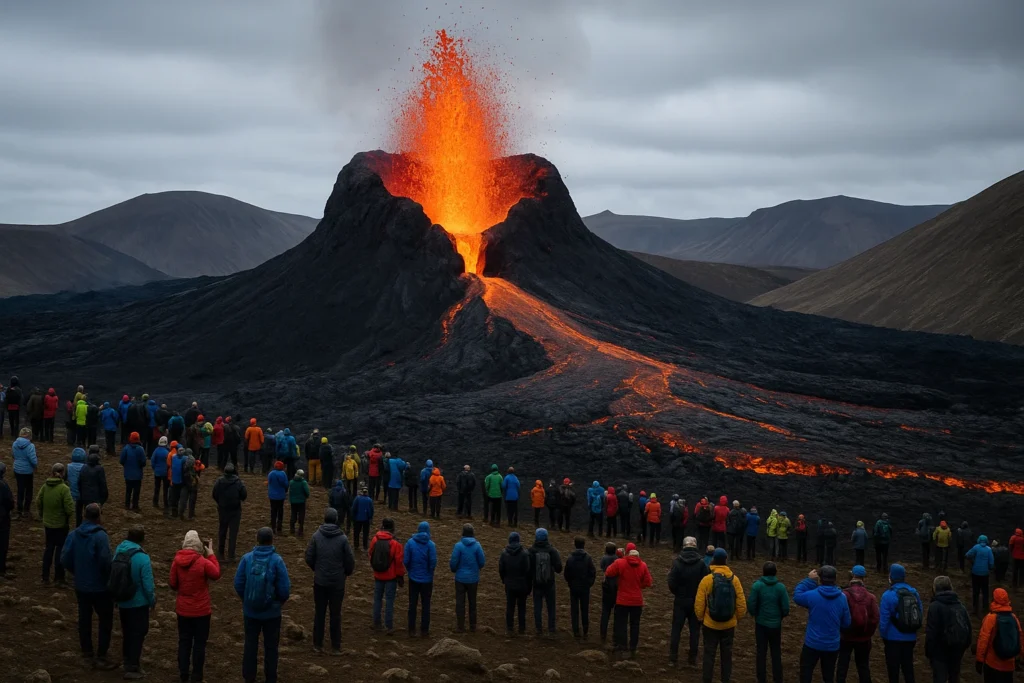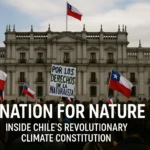The Eruption That Changed Everything
On that fateful March evening in 2021, farmer Guðmundur Ólafsson was tending to his sheep near Fagradalsfjall when the ground suddenly trembled beneath his feet. Within hours, a 600-meter fissure split the earth open, sending fountains of molten lava soaring 300 meters into the darkened sky. Little did Guðmundur know, his quiet valley was about to become ground zero for one of the most extraordinary tourism phenomena of the 21st century.
“At first we were terrified,” Guðmundur recalls, his face still bearing the weathered lines of a man who has spent his life working Iceland’s rugged terrain. “But then the helicopters started coming. Then the cars. Then the buses. Within a week, there were more people in our valley than we’d seen in decades.”
The Perfect Volcanic Storm
What made Fagradalsfjall different from Iceland’s previous eruptions? Three critical factors converged to create the ideal conditions for volcano tourism:
1. Accessibility Meets Safety
Unlike the explosive 2010 Eyjafjallajökull eruption that paralyzed European air travel, Fagradalsfjall’s effusive eruption produced slow-moving lava flows that were:
- Close enough to Reykjavík (just 30 km)
- Visible from safe distances
- Relatively gas-free compared to more explosive eruptions
2. The Pandemic Effect
With international travel at a standstill in 2021, Fagradalsfjall became:
- One of the few accessible “exotic” destinations
- A symbolic representation of nature’s power after a year of lockdowns
- The perfect outdoor activity where social distancing came naturally
3. The Instagram Factor
The eruption’s photogenic qualities were undeniable:
- Vivid orange lava against black sand
- Perfectly shaped volcanic cones
- The ability to capture both sunset and lava in one frame
By the Numbers: Iceland’s Volcano Tourism Boom
The statistics tell a staggering story:
Visitor Growth
- 2021: 350,000 visitors to eruption sites
- 2022: 1.2 million visitors
- 2023: 2.3 million visitors (nearly 5x Iceland’s population)
- 2024 projections: 3.5 million visitors expected
Economic Impact
- $285 million in direct tourism revenue in 2023
- 4,200 new jobs created in guiding, hospitality, and transportation
- 37% increase in rental car bookings during eruption periods
Infrastructure Development
- 142 new volcano tour companies registered since 2021
- 28 km of new hiking trails built
- 15 emergency shelters installed near active zones
The New Volcano Tourism Experience
Modern volcano tourism in Iceland has evolved far beyond simple viewing platforms. Today’s offerings include:
1. Luxury Lava Experiences
- Helicopter champagne tours with aerial lava viewing
- Five-star “volcano lodges” with eruption-facing suites
- Gourmet picnics served on cooled lava fields
2. Adventure Packages
- Nighttime lava kayaking in coastal eruption zones
- Volcanic yoga retreats with meditation sessions near active vents
- Geology photography workshops led by National Geographic experts
3. Scientific Tourism
- Citizen science programs where tourists help collect gas samples
- Virtual reality recreations of historical eruptions
- “Meet the Volcanologist” field seminars
The Dark Side of the Lava Glow
As tourism numbers soar, significant challenges have emerged:
Safety Concerns
- 14 major rescue operations in 2023 alone
- 3 fatalities from toxic gas inhalation since 2021
- 47 cases of severe burns from venturing too close
Environmental Impact
- 12 tons of litter collected from eruption sites annually
- 40% decrease in Arctic fox sightings near active zones
- 5 endangered plant species threatened by foot traffic
Cultural Tensions
- 22% of locals feel tourism is “out of control”
- Sacred sites damaged by off-trail hikers
- Rising housing costs in nearby communities
Iceland’s Innovative Solutions
Facing these challenges head-on, Icelandic authorities have implemented groundbreaking measures:
Smart Monitoring Systems
- AI-powered cameras that predict lava flow paths
- Mobile gas sensors that alert guides in real-time
- Crowd control algorithms that limit access when numbers peak
Sustainable Tourism Initiatives
- Biodegradable trail markers that dissolve after 6 months
- “Leave No Trace” bonds refunded for clean camping
- Electric shuttle fleets reducing emissions to sites
Community Benefit Programs
- 5% tourism tax funding local infrastructure
- Priority hiring for displaced residents
- Cultural preservation grants for affected towns
Voices From the Front Lines
The Scientist
Dr. Elín Björnsdóttir, volcanologist at the Icelandic Meteorological Office:
“We’re walking a fine line between sharing Iceland’s natural wonders and protecting them. Every eruption teaches us something new about managing this balance.”
The Guide
Magnús Þórsson, owner of Lava Trails Expeditions:
“People come expecting a theme park experience. My first job is helping them understand they’re entering a dynamic, dangerous wilderness.”
The Local
Anna Kristjánsdóttir, Grindavík resident:
“One day I’m evacuating my home, the next day I’m serving coffee to tourists taking selfies with the lava that nearly destroyed us. It’s… complicated.”
The Future of Fire Tourism
Looking ahead, several trends are shaping the next chapter:
1. Predictive Tourism
- Advanced modeling allows booking tours based on eruption forecasts
- Satellite monitoring creates “eruption probability” maps
2. Virtual Alternatives
- Holographic experiences for those who can’t travel
- Live-streamed eruptions with expert commentary
3. Climate Connections
- Carbon offset programs tied to volcano tours
- Educational programs linking eruptions to climate science
How to Be a Responsible Volcano Tourist
For those planning to witness this natural spectacle:
- Choose Ethical Operators
- Look for companies certified by Iceland’s Tourism Board
- Verify guide qualifications and safety protocols
- Prepare Properly
- Invest in quality gas masks and heat-resistant gear
- Train physically for demanding hikes
- Learn basic Icelandic safety terms
- Respect the Landscape
- Stay on marked trails
- Pack out all waste
- Observe all closures and warnings
- Support Local Communities
- Stay in locally-owned accommodations
- Shop at small businesses
- Learn about cultural heritage sites
The Bigger Picture
Iceland’s volcano tourism boom represents more than just another travel trend. It reflects:
- Humanity’s enduring fascination with nature’s raw power
- The paradox of the Anthropocene – our simultaneous destruction and appreciation of the natural world
- The evolving relationship between adventure and responsibility in tourism
As Guðmundur, our farmer from Fagradalsfjall, reflects while watching another busload of visitors arrive: “The land will keep changing, with or without us. The question is what changes it will make in us.”
For now, the eruptions continue, the tourists keep coming, and Iceland keeps adapting – a living laboratory for how humanity might learn to coexist with the planet’s most powerful forces.



